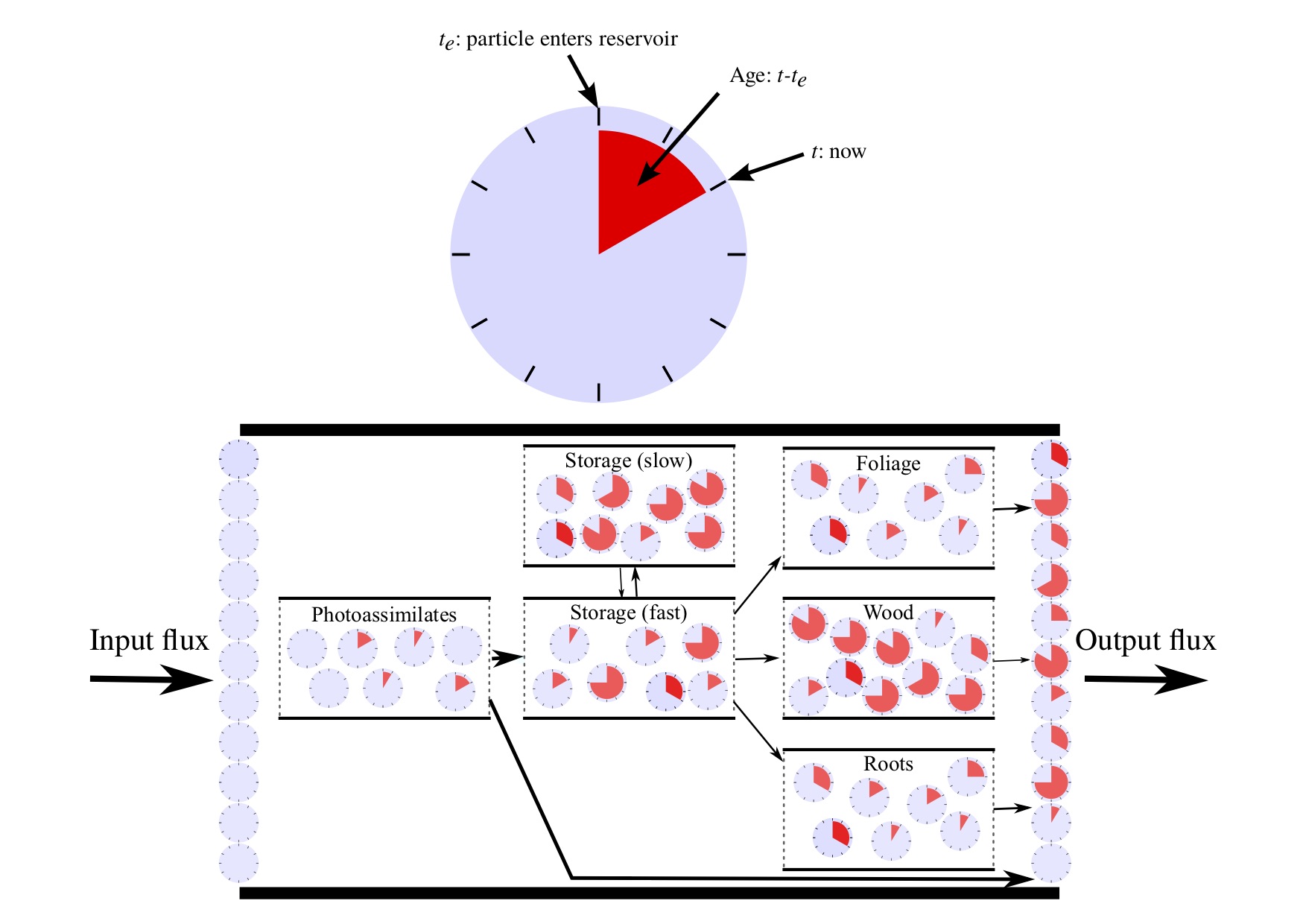Research
In the Theoretical Ecosystem Ecology group of the Max Planck Institute for Biogeochemistry, we study interactions and feedbacks between the carbon cycle and the climate system. We develop theoretical concepts and numerical software, and collect diverse data from ecosystems, to understand how climate affects metabolic rates in ecosystems and how changes in these metabolic rates affect the climate system.
Research themes
Timescales of carbon and element cycling in the terrestrial biosphere
We have made relevant contributions to the undesrtanding of the timescales at which carbon is cycled in natural systems. Our group developed mathematical and computational methods to obtain the age and the transit time of elements in mass balanced systems (compartmental systems) (Sierra et al., 2017; Metzler & Sierra, 2018; Metzler et al., 2018). We have applied these methods to study for how long can trees survive without new photosynthetic inputs (Herrera-Ramírez et al., 2020); to determine the age of soil carbon and the time that new carbon remains stored as soil organic matter (Sierra et al., 2018; Xiao et al., 2022; Sierra et al., 2024; Wang et al., 2024); to determine the time it takes for carbon to transit through a tropical rain forest (Sierra et al., 2021); and how the transit time of carbon for the entire terrestrial biosphere has changed during the industrial period (Sierra et al., 2023).
We are currently using measurements of radiocarbon in carbon dioxide to determine the transit time of carbon in ecosystems, and to compare these measurements with ecosystem models.

Control of the carbon-climate system and carbon cycle management
Our gains in conceptual understanding of carbon-climate interactions has allowed us to explore new concepts and methods to manage the carbon cycle for the purpose of climate change mitigation. We proposed a new definition of Carbon Sequestration (CS) to better quantify for how long carbon that is kept out of the atmosphere helps to mitigate climate change (Sierra et al., 2021; Crow & Sierra, 2022). We also develope a new concept called the Climate Benefit of Sequestration (CBS) that allow us to quantify how much warming is avoided when carbon is stored inside an ecosystem (Sierra et al., 2021).
We also proposed ideas about how to effectively control the carbon-climate system using knowledge on the rates at which carbon is transferred among different reservoirs within the Earth system such as the biosphere, the atmosphere and the oceans (Sierra et al., 2021). We believe that it is possible to express the problem of carbon cycle management as a congestion problem of networks, in which we assume that fossil fuel carbon is accumulating in the atmosphere because it cannot be processed fast enough by the land and the oceans.

Current Projects



Previous Projects





References
- Sierra, C. A., Ahrens, B., Bolinder, M. A., Braakhekke, M. C., von Fromm, S., Kätterer, T., Luo, Z., Parvin, N., & Wang, G. (2024). Carbon sequestration in the subsoil and the time required to stabilize carbon for climate change mitigation. Global Change Biology, 30(1), e17153. https://doi.org/https://doi.org/10.1111/gcb.17153
- Wang, G., Wang, M., Xiao, L., Sierra, C. A., Chang, J., Shi, Z., & Luo, Z. (2024). Fast Transit of Carbon Inputs in Global Soil Profiles Regardless of Entering Depth. Earth’s Future, 12(2), e2023EF003982. https://doi.org/10.1029/2023EF003982
- Sierra, C. A., Quetin, G. R., Metzler, H., & Müller, M. (2023). A decrease in the age of respired carbon from the terrestrial biosphere and increase in the asymmetry of its distribution. Philosophical Transactions of the Royal Society A: Mathematical, Physical and Engineering Sciences, 381(2261), 20220200. https://doi.org/10.1098/rsta.2022.0200
- Crow, S. E., & Sierra, C. A. (2022). The climate benefit of sequestration in soils for warming mitigation. Biogeochemistry, 161, 71–84. https://doi.org/10.1007/s10533-022-00981-1
- Xiao, L., Wang, G., Wang, M., Zhang, S., Sierra, C. A., Guo, X., Chang, J., Shi, Z., & Luo, Z. (2022). Younger carbon dominates global soil carbon efflux. Global Change Biology, 28(18), 5587–5599. https://doi.org/https://doi.org/10.1111/gcb.16311
- Sierra, C. A., Metzler, H., Müller, M., & Kaiser, E. (2021). Closed-loop and congestion control of the global carbon-climate system. Climatic Change, 165(1), 15. https://doi.org/10.1007/s10584-021-03040-0
- Sierra, C. A., Crow, S. E., Heimann, M., Metzler, H., & Schulze, E.-D. (2021). The climate benefit of carbon sequestration. Biogeosciences, 18(3), 1029–1048. https://doi.org/10.5194/bg-18-1029-2021
- Sierra, C. A., Estupinan-Suarez, L. M., & Chanca, I. (2021). The fate and transit time of carbon in a tropical forest. Journal of Ecology, 109(8), 2845–2855. https://doi.org/10.1111/1365-2745.13723
- Sierra, C. A., Estupinan-Suarez, L. M., & Chanca, I. (2021). The fate and transit time of carbon in a tropical forest. Journal of Ecology, 00(n/a), 11. https://doi.org/https://doi.org/10.1111/1365-2745.13723
- Herrera-Ramírez, D., Muhr, J., Hartmann, H., Römermann, C., Trumbore, S., & Sierra, C. A. (2020). Probability distributions of nonstructural carbon ages and transit times provide insights into carbon allocation dynamics of mature trees. New Phytologist, 226(5), 1299–1311. https://doi.org/10.1111/nph.16461
- Metzler, H., Müller, M., & Sierra, C. A. (2018). Transit-time and age distributions for nonlinear time-dependent compartmental systems. Proceedings of the National Academy of Sciences, 115(6), 1150–1155. https://doi.org/10.1073/pnas.1705296115
- Metzler, H., & Sierra, C. A. (2018). Linear Autonomous Compartmental Models as Continuous-Time Markov Chains: Transit-Time and Age Distributions. Mathematical Geosciences, 50(1), 1–34. https://doi.org/10.1007/s11004-017-9690-1
- Sierra, C. A., Hoyt, A. M., He, Y., & Trumbore, S. E. (2018). Soil Organic Matter Persistence as a Stochastic Process: Age and Transit Time Distributions of Carbon in Soils. Global Biogeochemical Cycles, 32(10), 1574–1588. https://doi.org/10.1029/2018GB005950
- Sierra, C. A., Müller, M., Metzler, H., Manzoni, S., & Trumbore, S. E. (2017). The muddle of ages, turnover, transit, and residence times in the carbon cycle. Global Change Biology, 23(5), 1763–1773. https://doi.org/10.1111/gcb.13556